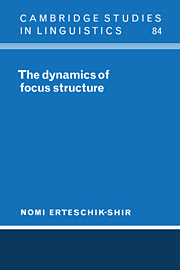Book contents
- Frontmatter
- Contents
- Acknowledgments
- Introduction
- 1 The interpretation of f-structure
- 2 Reference and coreference
- 3 Negation, questions, and contrast
- 4 The phonological interpretation of f-structure
- 5 Scope and R-dependencies
- 6 I-dependencies in focus structure
- Conclusion
- Notes
- References
- Index of names
- Index of subjects
1 - The interpretation of f-structure
Published online by Cambridge University Press: 02 September 2009
- Frontmatter
- Contents
- Acknowledgments
- Introduction
- 1 The interpretation of f-structure
- 2 Reference and coreference
- 3 Negation, questions, and contrast
- 4 The phonological interpretation of f-structure
- 5 Scope and R-dependencies
- 6 I-dependencies in focus structure
- Conclusion
- Notes
- References
- Index of names
- Index of subjects
Summary
Watt's instructions were to give what Mr Knott left of this dish, on the days that he did not eat it all, to the dog. …
But was a dog the same thing as the dog? For in Watt's instructions there was no mention of a dog, but only of the dog, which could only mean that what was required was not any dog, but one particular dog, that is to say, not one dog one day, and the next another, and perhaps the next a third, no, but every day the same, every day the same poor old dog, as long as the dog lived. But a fortiori were several dogs the same thing as the dog?
Samuel Beckett, Watt (New York: Grove Press, 1959[1953]), pp. 91, 96Focus structure
I use the term focus structure (f-structure) to characterize structural descriptions (SDs) annotated for topic and focus constituents. F-structure feeds both PF (Phonological Form) and Semantics. It feeds PF since this level provides the explicit phonetic spell-out including intonation. (Intonation is discussed in chapter 4.) I argue that f-structure and not LF (Logical Form) is the input to a semantic rule of Predication.
This chapter introduces the discourse theory to which f-structure provides the input. Interpreting f-structure is a dynamic venture, in the sense that the f-structure of a sentence determines its information-change potential. A sentence is thus viewed as a means of changing the information state of the interpreter or hearer. The part of the information state which the hearer has in common with the speaker is the common ground.
- Type
- Chapter
- Information
- The Dynamics of Focus Structure , pp. 7 - 59Publisher: Cambridge University PressPrint publication year: 1998



